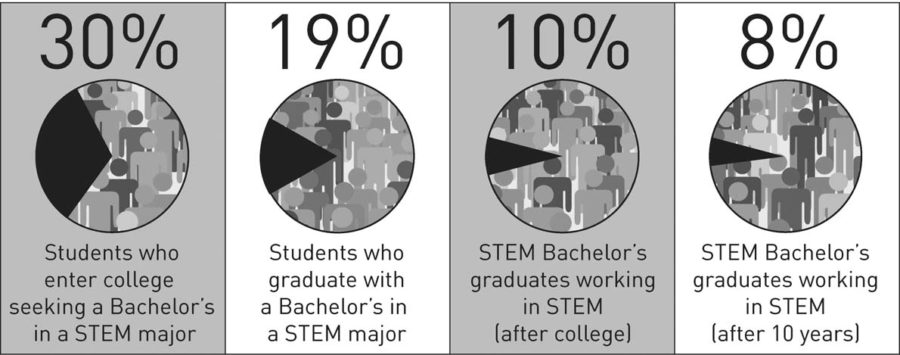Hanton: Lack of STEM employees could hurt everyone
Graphic: Kelsey Kremer/Iowa State Daily
The lack of graduates in the fields of science, technology, engineering, and mathematics is a problem that could be solved by taking a closer look at our education system and promoting programs that encourage students to enter STEM fields.
November 7, 2011
We live in an incredible time. Our parents saw the development of the personal computer and the Internet. Will we have prolific maglev trains and space travel by the time we are in our 40s and 50s? Who knows?
In any case, what we do know is that our business and personal lives will make heavy use of science and technology to make our lives easier. One result of that fact is that most industries will require more science, technology, engineering or mathematics knowledge.
A new report on Oct. 20 funded by the Lumina Foundation and the Bill and Melinda Gates Foundation and conducted by the Georgetown University Center on Education and the Workforce reported that we may lack enough graduates in STEM careers over the next decade. This isn’t because we are not graduating a large number of new engineers, mathematicians and scientists. It is because so many are currently defecting from STEM career paths during and after college.
Right now, 19 percent of students graduating with a bachelor’s degree in the United States graduate in a STEM-related field, but many who start school in STEM majors graduate in an entirely different field. Of those who graduate in STEM, just more than half actually take up STEM-related careers like physics, engineering or biology post-graduation. Some of those individuals soon end up vacating their positions to move into higher paying management or business positions as well.
With so many businesses counting on these science-minded professionals to advance their businesses, getting enough students into the field to counteract any attrition is vitally important. Even for the many students here who are not in STEM majors, you will likely work with science or technology professionals on a daily basis, so this is a problem affecting your future success too.
So what can we do about this?
Well, one solution is to examine how our education system works and doesn’t work. From my research, it seems that you should not necessarily listen to those who shout about a massive percentage of STEM students coming from schools in Asia and China. Their system generates a large percentage of STEM students partially due to the fact that few countries there have a universal education system like the United States. Similarly, if we only taught affluent students in the United States, we too would likely have a higher percentage of STEM interest.
But on the other hand, some reports do note that Eastern schools tend to delve deeper into core topics than schools in the United States and that they are not deeply tied to major book publishers as we are. I hope that in the next 10 to 15 years perhaps a few professors will have an “iTunes” moment and realize that they can publish cheaper textbooks directly using the e-book format and a bookstore like Amazon.com. This would allow a greater variety of texts to proliferate and would weed out the poorer texts easily.
While that is happening, there are a few other programs that may convince more students to enter science and technology fields. Among these are For Inspiration and Recognition of Science and Technology or “FIRST” — an organization started by inventor Dean Kamen and supported by thousands of engineers, scientists and teachers around the world.
Organizations like FIRST are trying to teach students about the fun in science and engineering and change the stereotype that science is not “cool.” To this end, I’m happy that a few high-profile individuals have voiced loud support for FIRST over the last few years. Everybody from will.i.am to President Barack Obama to Snoop Dogg has been showing their support of the yearly robotics competition that Kamen has arranged since 1992.
It isn’t just this one competition either. FIRST robotics doesn’t exactly have a college equivalent, but the lessons it teaches are applicable in many different project-based college groups. As we showed ISU graduate and astronaut Clayton Anderson our lunar mining robot in Howe Hall the other day, he remarked a few times that “we didn’t have this when I was in school.” This and other new competitions have been arranged in recent years to teach students basic science and engineering techniques.
So kudos to you if you have persevered and are still studying a science or engineering major as many of us are at Iowa State University. I wish you the best and can tell you that based on this research, you have a bright future if you choose to continue working in your field. I hope this new report inspires engineers and non-engineers alike to help with programs like FIRST.
As I have described over the past few weeks, science and technology are important to our nation and the world. Math and science are tough to master, but necessary to maintain our technologically advanced world. With a bit of work though, math and science can still provide a lot of fun and an enjoyable career.







